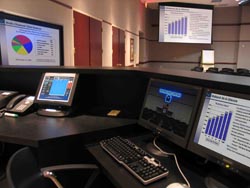Tier By Tier

- The largest training room that Sensory integrated at Midland's headquarters consists of two 184-inch screens and four plasma screens with interactive whiteboard overlays. In the back corner of the room is a control desk that features a Yamaha mixing console, a Crestron touchpanel, and two small LCD screens for controlling slides and streaming of the presentations. AMELIA, OH-Sensory Technologies recently completed AV systems for a multi-phase renovation and new construction of The Midland Company's national headquarters in Amelia, OH. With more than 30 separate meeting spaces that included conference rooms ranging in size and capability, this proved to be quite a large job.
- John Culp, Sensory's business development manager, explained Midland's goals for the project. "The goal overall was to have a state-of-the-art training facility for internal use and for bringing clients in from outside. Overall, the facility needed to be used for day-to-day meetings and other activities. Part of the project was a new facility, but we also went into the existing building to integrate those rooms as well. Originally it was just a seven-floor building and a conference center. Recently they added another building with six more floors."
- The rooms ranged from simple audio conferencing setups to large displays with interactive whiteboards. There were four large training rooms that featured two 119-inch widescreens, multiple computer inputs, and wireless microphones. Also included in most of the rooms were Crestron touchpanel controls to keep it simple for the revolving users.
Rooms other than those for training were split into tiers, based on the complexity of the system. While tier 1 rooms feature a manual sound screen, a projector, and an audio conferencing device, tier 5 rooms have a presentation system with touchpanel control and plasma screens.
The largest training room consists of two 184-inch screens and four plasma screens with interactive whiteboard overlays. The idea of the multitude of screens was that the two big screens would be used for larger groups and the plasmas would be used for break-out sessions within the room. A remote camera was placed to track presenters as they might stroll around the room. In the back corner of the room is a control desk that features a Yamaha mixing console, a Crestron touchpanel, and a couple small LCD screens for controlling slides and streaming of the presentations. An archiving feature allows Midland to save all functions within the room for future distribution.
The rest of the rooms were split into tiers, based on the complexity of the system. While tier 1 rooms feature a manual sound screen, a projector, and an audio conferencing device, tier 5 rooms have a presentation system with touch panel control and plasma screens.
All of the projectors used were Panasonic, except in certain cases where a Mitsubishi projector was used because of size constraints. All the projection screens were Draper. The ceiling speakers were a mix of Atlas Sound FAP62Ts and Electro-Voice. Audioconferencing units were Biamp Nexia TC and the Crestron touchpanels were all STX-1700CWs.
Culp explained Midland's reasoning behind the systems: "Midland wanted a quality product to train internal employees. The resulting robust solution offers its employees and outside visitors training and presentation spaces that are capable of handling basically any situation."
A daily selection of the top stories for AV integrators, resellers and consultants. Sign up below.
